S
smart ass
Гостин
Се надевам на интересна дискусија-бидејќи има простор.
Но првен еден мал вовед,имено после втората светска војна знаеме дека светот се подели,од една страна беше НАТО-пактот,а од друга Варшавскиот,САД на чело на првиот Екс СССР на вториот...чии членки сега се во НАТО,но во таков биполарен свет+идеолошка разлика повеќе од јасно беше дека ќе има страв и кај двете страни,имено Америте се плашеа од изненаден нуклеарен напад,а и СССР Исто-фала богу не се случи инаку би водел кон деструкција на двете држави,но и тешки последици врз светот(ако не и негово уништување),значи започна т.н трка на вооружување,се произведуваше оружје ненормално јасно тоа е студената војна која патем беше повеќе психолошка и игра со нерви...нејсе НАТО-вци се плашеа од советските Т-55ки(имаме цифра гоолема илјади) а подоцна и од останатите модели па така и Западот возврати па они штанцаа оружје..
Но трката во вооружување не застана само кај конвенционалното оружје,туку и оружјето за масовно уништување влезе во игра...Посебно нуклеарното...пред 35 години во светот имаше над 40000 Нуклеарни боеви глави-дали е доказ на креативност или ступидност-пресудете.
Покрај Интерконтиненталните ракети(ICBM) Како и подоцна методот на 'достава' од подморници(SLBM=Submarine Launched Ballistic missile)...Има и друг начин,кој пате може да има повеќенаменска употреба,а тоа е се разбира насловот на темата имено овие покрај што можат да достават нуклеарно оружје-истите можат да се употребат и за бомбардирање на повеќе мети,а и нивниот спектар на оружје е доста широк-согласно потребите.
имено овие покрај што можат да достават нуклеарно оружје-истите можат да се употребат и за бомбардирање на повеќе мети,а и нивниот спектар на оружје е доста широк-согласно потребите.
Еве ќе го претставам мојот омилен-покрај блекџек-от.
B-1B е интерконтинентален стратегиски бомбардер . Истиот во пракса се докажа во првата заливска војна како и втората,имено се проценува дека од вкупниот payload 30% е баш од овој тип на авион кој патем држи 43 рекорди.-Во низок лет...маестрално.

за разлика од неговиот претходник Б-1А од 70-сетите
The B-1B's electronic jamming equipment, infrared countermeasures, radar location and warning systems complement its low-radar cross-section and form an integrated defense system for the aircraft.
The swing-wing design and turbofan engines not only provide greater range and high speed at low levels but they also enhance the bomber's survivability. Wing sweep at the full-forward position allows a short takeoff roll and a fast base-escape profile for airfields under attack. Once airborne, the wings are positioned for maximum cruise distance or high-speed penetration. The B-1B holds several world records for speed, payload and distance. The National Aeronautic Association recognized the B-1B for completing one of the 10 most memorable record flights for 1994.
The B-1B uses radar and inertial navigation equipment enabling aircrews to globally navigate, update mission profiles and target coordinates in-flight, and precision bomb without the need for ground based navigation aids. Included in the B-1B offensive avionics are modular electronics that allow maintenance personnel to precisely identify technical difficulties and replace avionics components in a fast, efficient manner on the ground.
Би напоменал дека за разлика од Б-2 кој е екстремно скап(над 2 милијарди долари) а америте имале план да произведат минимум 90 Б-2-ки но СССР се распадна па така и буџетот на САД не претрпе сериозни последици.
Карактеристично за Б-1Б е што е еден од ретките бомбардери стратегиски кои Еволуираат,имео,за истиот има повеќе програми за развој.
The aircraft's AN/ALQ 161A defensive avionics is a comprehensive electronic counter-measures package that detects and counters enemy radar threats. It also has the capability to detect and counter missiles attacking from the rear. It defends the aircraft by applying the appropriate counter-measures, such as electronic jamming or dispensing expendable chaff and flares. Similar to the offensive avionics, the defensive suite has a re-programmable design that allows in-flight changes to be made to counter new or changing threats.
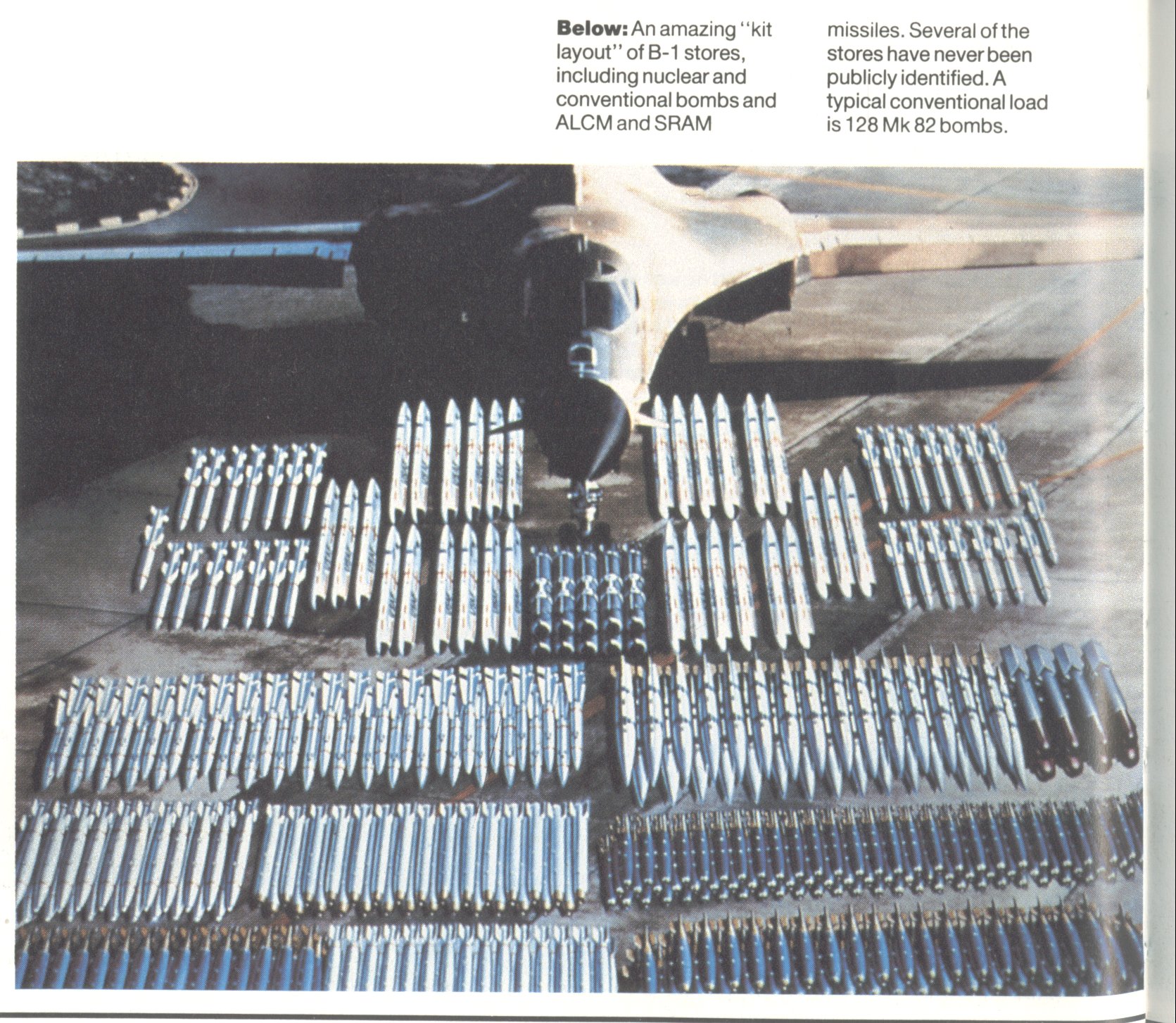
(American subsonic air-launched cruise missile (ALCM) и(Short-range attack missile SRAM)
The B-1B represents a major upgrade in U.S. long-range capabilities over the B-52 -- the previous mainstay of the bomber fleet. Significant advantages include:
* Low radar cross-section to make detection considerably more difficult.
* Ability to fly lower and faster while carrying a larger payload.
* Advanced electronic countermeasures to enhance survivability.
Numerous sustainment and upgrade modifications are ongoing or under study for the B-1B aircraft. A large portion of these modifications which are designed to increase the combat capability are known as the Conventional Mission Upgrade Program. In FY93, The Air Force initiated CMUP in FY1993 to improve the B-1’s conventional warfighting capabilities. The $2.7 billion CMUP program is intended to convert the B-1B from a primarily nuclear weapons carrier to a conventional weapons carrier. Capability will be delivered in blocks attained by hardware modifications with corresponding software updates:
* Initial conventional capability was optimized for delivery of Mk-82 non-precision 500lb gravity bombs
* Current capability (Block C) also provides delivery of up to 30 Cluster Bomb Units (CBUs) per sortie for enhanced conventional capability against advancing armor. Initial capability achieved in September 1996 with FOC in August 1997. The upgrade consists of modification for B-1B bomb module from the original configuration of 28 500-pound bombs per unit to 10 1,000-pound cluster bombs per bomb rack. The modifications apply to a total to 50 refitted bomb racks -- enough to equip half the B-1B fleet.
* Block D integrates the ALE-50 repeater decoy system, the first leg of the electronic countermeasures upgrade, and JDAM for near precision capability and adds anti-jam radios for secure communication in force packages. FY96 and FY97 Congressional plus-ups are being used to accelerate JDAM initial capability by 18 months (1QFY99). Congress has provided extra funding to allow a group of seven aircraft to be outfitted and ready a full 18 months early, with the first three JDAM equipped aircraft to be ready by December 1998, and the last of those seven aircraft are planned to arrive at Ellsworth AFB by Feb 99.
* Block E upgrades the current avionics computer suite and integrates Wind Corrected Munitions Dispenser (WCMD), Joint Standoff Weapon (JSOW) and Joint Air to Surface Standoff Missile (JASSM) for standoff capability (FY02)
* Block F improves the aircraft’s electronic countermeasures’ situational awareness and jamming capabilities in FY02.
Во акција
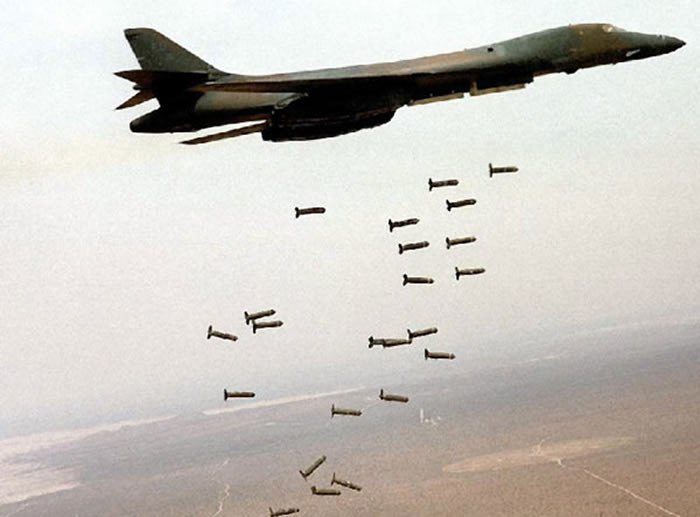
Кој си го бара-го добива Резултати од Праксата со песна од AC/DC
Како што можеме да забележиме и покрај одличните офанзивни способности Б-1Б исто така поседува исклучително добра дефанзива,имено истиот може да забележи кога е лансирана ракета кон него,понатаму може да води буквално електронска војна односно да ги попречува непријателските Радари и противвоздушна одбрана.
Интересно
Кокпит-от

Кога е во прашање носивоста.
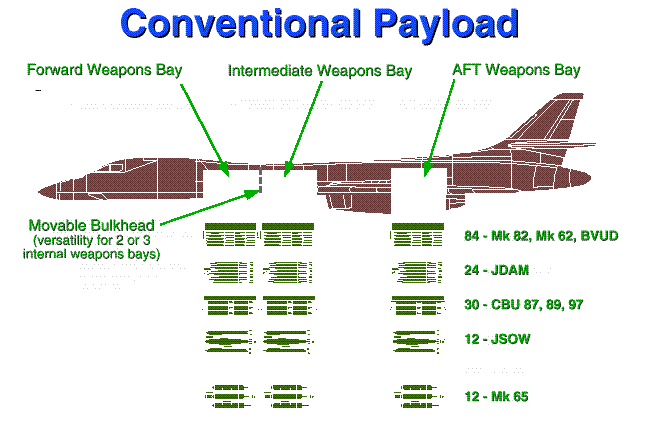
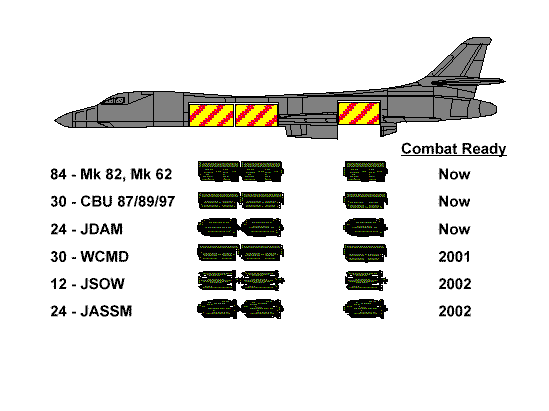
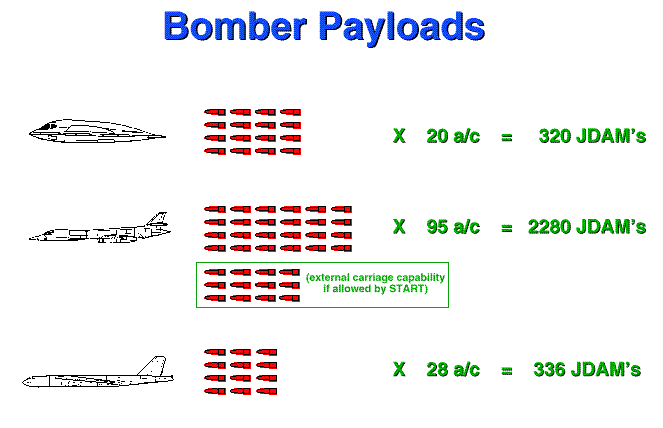
како што напоменав за разлика од екстремно скапиот Б-2 стелт кој чини 2.2 милијарди долари.
Б-1
Date Deployed: June 1985 Unit Cost: $200-plus million per aircraft Inventory: 100 total productionСамо да забележам дека од тие сто не се сите активни.
Тактичко технички карактеристики.
Primary Function: Long-range, multi-role, heavy bomber Builder: Rockwell International, North American Aircraft Operations Air Frame and Integration: Offensive avionics, Boeing Military Airplane; defensive avionics, AIL Division Power Plant: Four General Electric F-101-GE-102 turbofan engine with afterburner Thrust: 30,000-plus pounds (13,500-plus kilograms) with afterburner, per engine Length: 146 feet (44.5 meters) Wingspan: 137 feet (41.8 meters) extended forward, 79 feet (24.1 meters) swept aft Height: 34 feet (10.4 meters) Weight: Empty, approximately 190,000 pounds (86,183 kilograms) Maximum Takeoff Weight: 477,000 pounds (214,650 kilograms) Speed: 900-plus mph (Mach 1.2 at sea level) Rotate and Takeoff Speeds: 210 Gross - 119 Rotate kts / 134 kts Takeoff
390 Gross - 168 kts Rotate / 183 kts Takeoff Landing Speeds: 210 Gross - 145 kts
380 Gross - 195 kts Range: Intercontinental, unrefueled Ceiling: Over 30,000 feet (9,000 meters) Crew: Four (aircraft commander, pilot, offensive systems officer and defensive systems officer) Armament: NUCLEAR
CONVENTIONAL
84 Mk 62
84 MK82
30 CBU 87
30 CBU 89
30 CBU 97
12 Mk 65
PRECISION
30 WCMD
24 JDAM
12 GBU-27
12 AGM-154 JSOW
12 TSSAM

Некои подобрувања,и одговорните
Enhancements & Improvements
Enhancements G-1 K. Lynch
Safety, R&M Improvements G-2 R. Pasco
Conventional Capability G-3 K. Lynch
Bird Strike G-4 R. Woods 797-1768
Flight Control System G-5 N. Johnson
Engine Exhaust Nozzle Outer Flaps G-6 M. Benavides
Engine Ruggedized Fan Blades G-6 M. Benavides
Crew Turbocompressor Upgrades G-6 A. Erazo 7
Generator Control Unit and
System Integration Panel Redesign
G-7 B. Eaton 797-2054
EMUX Sparkle G-8 J. Eden-Logan 797-3796
CITS Upgrade G-9 N. Skillman
Ejection Seat Horizontal Positioning Actuator G-10 A. Erazo 797-2067
Fire Warning and Extinguishing Panel G-11 A. Erazo 797-2067
Ejection Seat Load Arrestor G-12 A. Erazo 797-2067
MSOGS and Horizontal Situation Indicator
(HSI) Electrical Power Sources
G-13 A. Erazo 797-2067
Short Range Attack Missile II G-14 A. D'Onofrio
Ice Protection G-15 M. Benavides 797-2077
Engine Inlet Ice Protection System G-16 M. Benavides
Instrument Landing System G-17 J. Eden-Logan
SCAS Servo Cylinder (Pitch / Roll) G-18 J. Kaulukukui
Flap / Slat and Controller Redesign G-19 J. Kaulukukui
Overwing Fairing Modification (FD/FI, SIM) G-20 D. Spory
A/C Locations Impacted G-21 J. Yosan
Но првен еден мал вовед,имено после втората светска војна знаеме дека светот се подели,од една страна беше НАТО-пактот,а од друга Варшавскиот,САД на чело на првиот Екс СССР на вториот...чии членки сега се во НАТО,но во таков биполарен свет+идеолошка разлика повеќе од јасно беше дека ќе има страв и кај двете страни,имено Америте се плашеа од изненаден нуклеарен напад,а и СССР Исто-фала богу не се случи инаку би водел кон деструкција на двете држави,но и тешки последици врз светот(ако не и негово уништување),значи започна т.н трка на вооружување,се произведуваше оружје ненормално јасно тоа е студената војна која патем беше повеќе психолошка и игра со нерви...нејсе НАТО-вци се плашеа од советските Т-55ки(имаме цифра гоолема илјади) а подоцна и од останатите модели па така и Западот возврати па они штанцаа оружје..
Но трката во вооружување не застана само кај конвенционалното оружје,туку и оружјето за масовно уништување влезе во игра...Посебно нуклеарното...пред 35 години во светот имаше над 40000 Нуклеарни боеви глави-дали е доказ на креативност или ступидност-пресудете.
Покрај Интерконтиненталните ракети(ICBM) Како и подоцна методот на 'достава' од подморници(SLBM=Submarine Launched Ballistic missile)...Има и друг начин,кој пате може да има повеќенаменска употреба,а тоа е се разбира насловот на темата
 имено овие покрај што можат да достават нуклеарно оружје-истите можат да се употребат и за бомбардирање на повеќе мети,а и нивниот спектар на оружје е доста широк-согласно потребите.
имено овие покрај што можат да достават нуклеарно оружје-истите можат да се употребат и за бомбардирање на повеќе мети,а и нивниот спектар на оружје е доста широк-согласно потребите.Еве ќе го претставам мојот омилен-покрај блекџек-от.
B-1B е интерконтинентален стратегиски бомбардер . Истиот во пракса се докажа во првата заливска војна како и втората,имено се проценува дека од вкупниот payload 30% е баш од овој тип на авион кој патем држи 43 рекорди.-Во низок лет...маестрално.

за разлика од неговиот претходник Б-1А од 70-сетите
The B-1B's electronic jamming equipment, infrared countermeasures, radar location and warning systems complement its low-radar cross-section and form an integrated defense system for the aircraft.
The swing-wing design and turbofan engines not only provide greater range and high speed at low levels but they also enhance the bomber's survivability. Wing sweep at the full-forward position allows a short takeoff roll and a fast base-escape profile for airfields under attack. Once airborne, the wings are positioned for maximum cruise distance or high-speed penetration. The B-1B holds several world records for speed, payload and distance. The National Aeronautic Association recognized the B-1B for completing one of the 10 most memorable record flights for 1994.
The B-1B uses radar and inertial navigation equipment enabling aircrews to globally navigate, update mission profiles and target coordinates in-flight, and precision bomb without the need for ground based navigation aids. Included in the B-1B offensive avionics are modular electronics that allow maintenance personnel to precisely identify technical difficulties and replace avionics components in a fast, efficient manner on the ground.
Би напоменал дека за разлика од Б-2 кој е екстремно скап(над 2 милијарди долари) а америте имале план да произведат минимум 90 Б-2-ки но СССР се распадна па така и буџетот на САД не претрпе сериозни последици.
Карактеристично за Б-1Б е што е еден од ретките бомбардери стратегиски кои Еволуираат,имео,за истиот има повеќе програми за развој.
The aircraft's AN/ALQ 161A defensive avionics is a comprehensive electronic counter-measures package that detects and counters enemy radar threats. It also has the capability to detect and counter missiles attacking from the rear. It defends the aircraft by applying the appropriate counter-measures, such as electronic jamming or dispensing expendable chaff and flares. Similar to the offensive avionics, the defensive suite has a re-programmable design that allows in-flight changes to be made to counter new or changing threats.

(American subsonic air-launched cruise missile (ALCM) и(Short-range attack missile SRAM)
The B-1B represents a major upgrade in U.S. long-range capabilities over the B-52 -- the previous mainstay of the bomber fleet. Significant advantages include:
* Low radar cross-section to make detection considerably more difficult.
* Ability to fly lower and faster while carrying a larger payload.
* Advanced electronic countermeasures to enhance survivability.
Numerous sustainment and upgrade modifications are ongoing or under study for the B-1B aircraft. A large portion of these modifications which are designed to increase the combat capability are known as the Conventional Mission Upgrade Program. In FY93, The Air Force initiated CMUP in FY1993 to improve the B-1’s conventional warfighting capabilities. The $2.7 billion CMUP program is intended to convert the B-1B from a primarily nuclear weapons carrier to a conventional weapons carrier. Capability will be delivered in blocks attained by hardware modifications with corresponding software updates:
* Initial conventional capability was optimized for delivery of Mk-82 non-precision 500lb gravity bombs
* Current capability (Block C) also provides delivery of up to 30 Cluster Bomb Units (CBUs) per sortie for enhanced conventional capability against advancing armor. Initial capability achieved in September 1996 with FOC in August 1997. The upgrade consists of modification for B-1B bomb module from the original configuration of 28 500-pound bombs per unit to 10 1,000-pound cluster bombs per bomb rack. The modifications apply to a total to 50 refitted bomb racks -- enough to equip half the B-1B fleet.
* Block D integrates the ALE-50 repeater decoy system, the first leg of the electronic countermeasures upgrade, and JDAM for near precision capability and adds anti-jam radios for secure communication in force packages. FY96 and FY97 Congressional plus-ups are being used to accelerate JDAM initial capability by 18 months (1QFY99). Congress has provided extra funding to allow a group of seven aircraft to be outfitted and ready a full 18 months early, with the first three JDAM equipped aircraft to be ready by December 1998, and the last of those seven aircraft are planned to arrive at Ellsworth AFB by Feb 99.
* Block E upgrades the current avionics computer suite and integrates Wind Corrected Munitions Dispenser (WCMD), Joint Standoff Weapon (JSOW) and Joint Air to Surface Standoff Missile (JASSM) for standoff capability (FY02)
* Block F improves the aircraft’s electronic countermeasures’ situational awareness and jamming capabilities in FY02.
Во акција

Кој си го бара-го добива Резултати од Праксата со песна од AC/DC
Како што можеме да забележиме и покрај одличните офанзивни способности Б-1Б исто така поседува исклучително добра дефанзива,имено истиот може да забележи кога е лансирана ракета кон него,понатаму може да води буквално електронска војна односно да ги попречува непријателските Радари и противвоздушна одбрана.
Интересно
The B-1B is part of the Single Integrated Operational Plan (SIOP) which allocates
strategic assets to specific targets. The B-1B SIOP penetration mission profile
consists of four phases: Takeoff and Cruise; Penetration and Weapon Delivery;
Withdrawal; and Recovery.
Takeoff for SIOP missions occur from continental U.S. bases. Cruise length is
variable depending on the target and mission and is accomplished at best cruise
altitude with inflight refueling as required. At penetration, the B-1B descends to
200 feet AGL and accelerates to a minimum of 0.85 Mach. Withdrawal is
accomplished at the same altitude at a minimum of 0.55 Mach. Recovery for a
SIOP mission occurs at a non-U.S. base and may include a climb to cruise altitude
as necessary.
The exact penetration distance flown varies with the specific category of B-1B
mission. Mission flexibility is afforded with the carriage of internal fuel in any or all
of the weapon bays through the installation of non-jettisonable, cylindrical fuel
tanks. For the longest missions, two bays may be loaded with fuel and only one
bay with weapons.
The SIOP penetration mission is one of five Specification Missions for the B-1B
used as a design reference. The other four being Shoot-Pen, Standoff, World
Wide Power Phase I, and World Wide Power Phase. The penetration mission is
most commonly used for mission analysis at this time.
Кокпит-от

Кога е во прашање носивоста.
- Block F improves the aircraft’s electronic countermeasures’ situational awareness and jamming capabilities in FY02



како што напоменав за разлика од екстремно скапиот Б-2 стелт кој чини 2.2 милијарди долари.
Б-1
Date Deployed: June 1985 Unit Cost: $200-plus million per aircraft Inventory: 100 total productionСамо да забележам дека од тие сто не се сите активни.
Тактичко технички карактеристики.
Primary Function: Long-range, multi-role, heavy bomber Builder: Rockwell International, North American Aircraft Operations Air Frame and Integration: Offensive avionics, Boeing Military Airplane; defensive avionics, AIL Division Power Plant: Four General Electric F-101-GE-102 turbofan engine with afterburner Thrust: 30,000-plus pounds (13,500-plus kilograms) with afterburner, per engine Length: 146 feet (44.5 meters) Wingspan: 137 feet (41.8 meters) extended forward, 79 feet (24.1 meters) swept aft Height: 34 feet (10.4 meters) Weight: Empty, approximately 190,000 pounds (86,183 kilograms) Maximum Takeoff Weight: 477,000 pounds (214,650 kilograms) Speed: 900-plus mph (Mach 1.2 at sea level) Rotate and Takeoff Speeds: 210 Gross - 119 Rotate kts / 134 kts Takeoff
390 Gross - 168 kts Rotate / 183 kts Takeoff Landing Speeds: 210 Gross - 145 kts
380 Gross - 195 kts Range: Intercontinental, unrefueled Ceiling: Over 30,000 feet (9,000 meters) Crew: Four (aircraft commander, pilot, offensive systems officer and defensive systems officer) Armament: NUCLEAR
CONVENTIONAL
84 Mk 62
84 MK82
30 CBU 87
30 CBU 89
30 CBU 97
12 Mk 65
PRECISION
30 WCMD
24 JDAM
12 GBU-27
12 AGM-154 JSOW
12 TSSAM

Некои подобрувања,и одговорните
Enhancements & Improvements
Enhancements G-1 K. Lynch
Safety, R&M Improvements G-2 R. Pasco
Conventional Capability G-3 K. Lynch
Bird Strike G-4 R. Woods 797-1768
Flight Control System G-5 N. Johnson
Engine Exhaust Nozzle Outer Flaps G-6 M. Benavides
Engine Ruggedized Fan Blades G-6 M. Benavides
Crew Turbocompressor Upgrades G-6 A. Erazo 7
Generator Control Unit and
System Integration Panel Redesign
G-7 B. Eaton 797-2054
EMUX Sparkle G-8 J. Eden-Logan 797-3796
CITS Upgrade G-9 N. Skillman
Ejection Seat Horizontal Positioning Actuator G-10 A. Erazo 797-2067
Fire Warning and Extinguishing Panel G-11 A. Erazo 797-2067
Ejection Seat Load Arrestor G-12 A. Erazo 797-2067
MSOGS and Horizontal Situation Indicator
(HSI) Electrical Power Sources
G-13 A. Erazo 797-2067
Short Range Attack Missile II G-14 A. D'Onofrio
Ice Protection G-15 M. Benavides 797-2077
Engine Inlet Ice Protection System G-16 M. Benavides
Instrument Landing System G-17 J. Eden-Logan
SCAS Servo Cylinder (Pitch / Roll) G-18 J. Kaulukukui
Flap / Slat and Controller Redesign G-19 J. Kaulukukui
Overwing Fairing Modification (FD/FI, SIM) G-20 D. Spory
A/C Locations Impacted G-21 J. Yosan









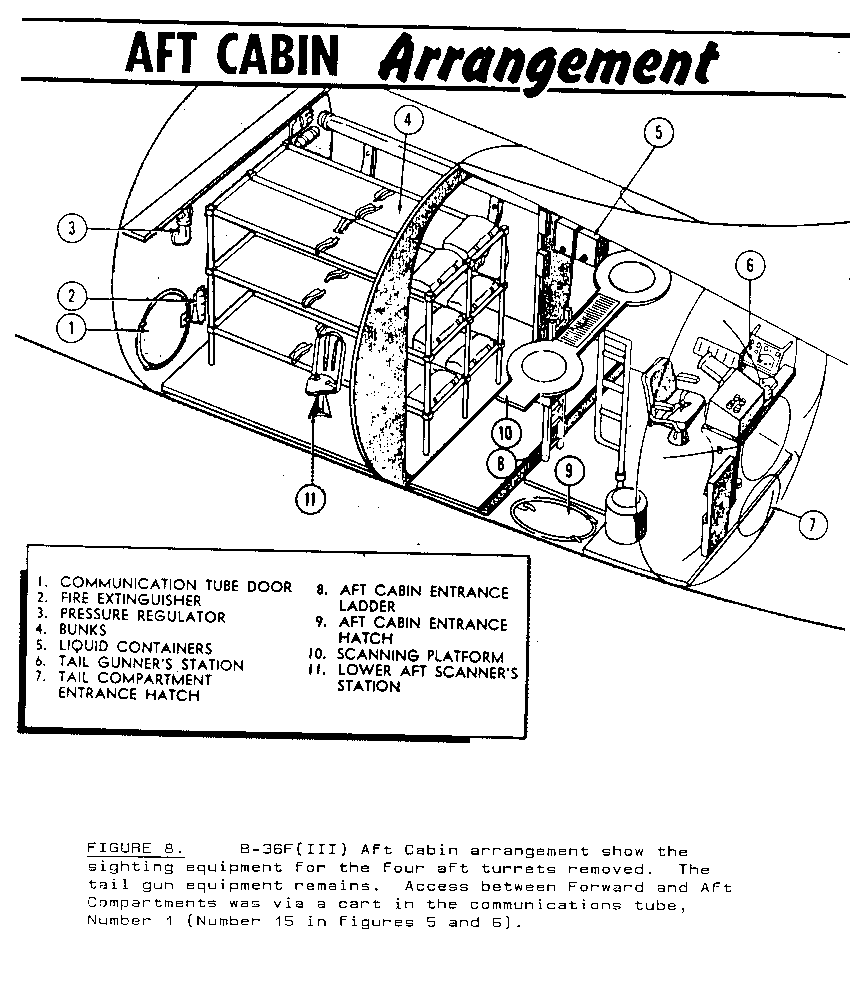











 231909 Fenomenalen update, istiot avion e
231909 Fenomenalen update, istiot avion e